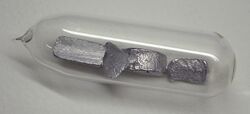Thallium, 81Tl |
| Thallium |
|---|
| Pronunciation | (THAL-ee-əm) |
|---|
| Appearance | silvery white |
|---|
| Standard atomic weight Ar, std(Tl) | [204.382, 204.385] conventional: 204.38 |
|---|
| Thallium in the periodic table |
|---|
|
|
| Atomic number (Z) | 81 |
|---|
| Group | group 13 (boron group) |
|---|
| Period | period 6 |
|---|
| Block | p-block |
|---|
| Element category | p-block |
|---|
| Electron configuration | [Xe] 4f14 5d10 6s2 6p1 |
|---|
| Electrons per shell | 2, 8, 18, 32, 18, 3 |
|---|
| Physical properties |
|---|
| Phase at STP | solid |
|---|
| Melting point | 577 K (304 °C, 579 °F) |
|---|
| Boiling point | 1746 K (1473 °C, 2683 °F) |
|---|
| Density (near r.t.) | 11.85 g/cm3 |
|---|
| when liquid (at m.p.) | 11.22 g/cm3 |
|---|
| Heat of fusion | 4.14 kJ/mol |
|---|
| Heat of vaporization | 165 kJ/mol |
|---|
| Molar heat capacity | 26.32 J/(mol·K) |
|---|
Vapor pressure
| P (Pa)
|
1
|
10
|
100
|
1 k
|
10 k
|
100 k
|
| at T (K)
|
882
|
977
|
1097
|
1252
|
1461
|
1758
|
|
| Atomic properties |
|---|
| Oxidation states | −5,[1] −2, −1, +1, +2, +3 (a mildly basic oxide) |
|---|
| Electronegativity | Pauling scale: 1.62 |
|---|
| Ionization energies | - 1st: 589.4 kJ/mol
- 2nd: 1971 kJ/mol
- 3rd: 2878 kJ/mol
-
|
|---|
| Atomic radius | empirical: 170 pm |
|---|
| Covalent radius | 145±7 pm |
|---|
| Van der Waals radius | 196 pm |
|---|
| Spectral lines of thallium |
| Other properties |
|---|
| Natural occurrence | primordial |
|---|
| Crystal structure | hexagonal close-packed (hcp) |
|---|
| Speed of sound thin rod | 818 m/s (at 20 °C) |
|---|
| Thermal expansion | 29.9 µm/(m·K) (at 25 °C) |
|---|
| Thermal conductivity | 46.1 W/(m·K) |
|---|
| Electrical resistivity | 0.18 µΩ·m (at 20 °C) |
|---|
| Magnetic ordering | diamagnetic[2] |
|---|
| Magnetic susceptibility | −50.9·10−6 cm3/mol (298 K)[3] |
|---|
| Young's modulus | 8 GPa |
|---|
| Shear modulus | 2.8 GPa |
|---|
| Bulk modulus | 43 GPa |
|---|
| Poisson ratio | 0.45 |
|---|
| Mohs hardness | 1.2 |
|---|
| Brinell hardness | 26.5–44.7 MPa |
|---|
| CAS Number | 7440-28-0 |
|---|
| History |
|---|
| Naming | after Greek thallos, green shoot or twig |
|---|
| Discovery | William Crookes (1861) |
|---|
| First isolation | Claude-Auguste Lamy (1862) |
|---|
| Main isotopes of thallium |
|---|
|
|
 Category: Thallium Category: Thallium
view · talk · edit
| references |
Tl data m.p. cat
|
| C
|
304
|
—
|
—
|
|
|
| K
|
577
|
577
|
0
|
|
|
| F
|
579
|
579
|
0
|
|
|
| max precision
|
0
|
| WD
|
|
|
|
|
| input
|
C: 304, K: 577, F: 579
|
| comment
|
|
Tl data b.p. cat
|
| C
|
1473
|
—
|
—
|
|
|
| K
|
1746
|
1746
|
0
|
|
|
| F
|
2683
|
2683
|
0
|
|
|
| max precision
|
0
|
| WD
|
|
|
|
|
| input
|
C: 1473, K: 1746, F: 2683
|
| comment
|
|
References
These references will appear in the article, but this list appears only on this page.
- ↑ Dong, Z.-C.; Corbett, J. D. (1996). "Na23K9Tl15.3: An Unusual Zintl Compound Containing Apparent Tl57−, Tl48−, Tl37−, and Tl5− Anions". Inorganic Chemistry 35 (11): 3107–12. doi:10.1021/ic960014z.
- ↑ Lide, D. R., ed (2005). "Magnetic susceptibility of the elements and inorganic compounds". CRC Handbook of Chemistry and Physics (86th ed.). Boca Raton (FL): CRC Press. ISBN 0-8493-0486-5. https://web.archive.org/web/20110303222309/http://www-d0.fnal.gov/hardware/cal/lvps_info/engineering/elementmagn.pdf.
- ↑ Weast, Robert (1984). CRC, Handbook of Chemistry and Physics. Boca Raton, Florida: Chemical Rubber Company Publishing. pp. E110. ISBN 0-8493-0464-4.
Template:Documentation


